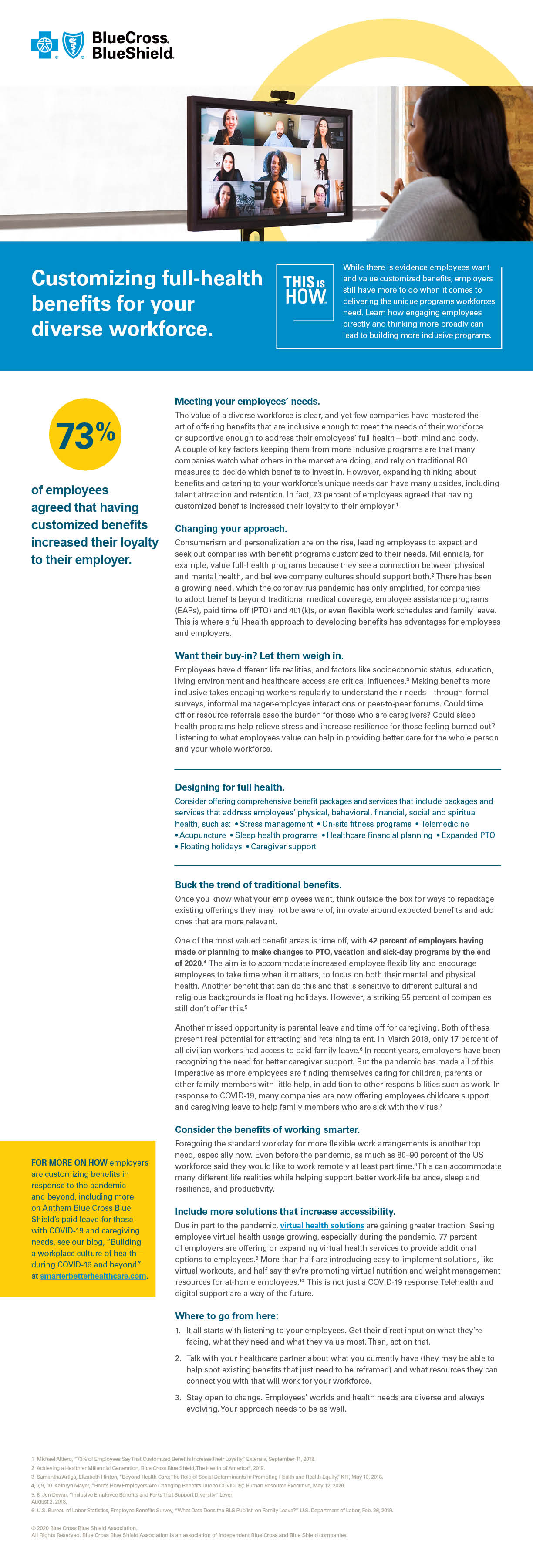Customizing Full-Health Benefits for Your Diverse Workforce

While there is evidence employees want and value customized benefits, employers still have more to do when it comes to delivering the unique programs workforces need. Learn how engaging employees directly and thinking more broadly can lead to building more inclusive programs.
73% of employees agreed that having customized benefits increased their loyalty to their employer.
Meeting your employees’ needs.
The value of a diverse workforce is clear, and yet few companies have mastered the art of offering benefits that are inclusive enough to meet the needs of their workforce or supportive enough to address their employees’ full health—both mind and body. A couple of key factors keeping them from more inclusive programs are that many companies watch what others in the market are doing, and rely on traditional ROI measures to decide which benefits to invest in. However, expanding thinking about benefits and catering to your workforce’s unique needs can have many upsides, including talent attraction and retention. In fact, 73 percent of employees agreed that having customized benefits increased their loyalty to their employer.1
Changing your approach.
Consumerism and personalization are on the rise, leading employees to expect and seek out companies with benefit programs customized to their needs. Millennials, for example, value full-health programs because they see a connection between physical and mental health, and believe company cultures should support both.2 There has been a growing need, which the coronavirus pandemic has only amplified, for companies to adopt benefits beyond traditional medical coverage, employee assistance programs (EAPs), paid time off (PTO) and 401(k)s, or even flexible work schedules and family leave. This is where a full-health approach to developing benefits has advantages for employees and employers.
Want their buy-in? Let them weigh in.
Employees have different life realities, and factors like socioeconomic status, education, living environment and healthcare access are critical influences.3 Making benefits more inclusive takes engaging workers regularly to understand their needs—through formal surveys, informal manager-employee interactions or peer-to-peer forums. Could time off or resource referrals ease the burden for those who are caregivers? Could sleep health programs help relieve stress and increase resilience for those feeling burned out? Listening to what employees value can help in providing better care for the whole person and your whole workforce.
Designing for full health.
Consider offering comprehensive benefit packages and services that address employees’ physical, behavioral, financial, social and spiritual health, such as:
- Stress management
- On-site fitness programs
- Telemedicine
- Acupuncture
- Sleep health programs
- Healthcare financial planning
- Expanded PTO
- Floating holidays
- Caregiver support
Buck the trend of traditional benefits.
Once you know what your employees want, think outside the box for ways to repackage existing offerings they may not be aware of, innovate around expected benefits and add ones that are more relevant.
One of the most valued benefit areas is time off, with 42 percent of employers having made or planning to make changes to PTO, vacation and sick-day programs by the end of 2020.4 The aim is to accommodate increased employee flexibility and encourage employees to take time when it matters, to focus on both their mental and physical health. Another benefit that can do this and that is sensitive to different cultural and religious backgrounds is floating holidays. However, a striking 55 percent of companies still don’t offer this.5
Another missed opportunity is parental leave and time off for caregiving. Both of these present real potential for attracting and retaining talent. In March 2018, only 17 percent of all civilian workers had access to paid family leave.6 In recent years, employers have been recognizing the need for better caregiver support. But the pandemic has made all of this imperative as more employees are finding themselves caring for children, parents or other family members with little help, in addition to other responsibilities such as work. In response to COVID-19, many companies are now offering employees childcare support and caregiving leave to help family members who are sick with the virus.7
FOR MORE ON HOW employers are customizing benefits in response to the pandemic and beyond, including more on Anthem Blue Cross Blue Shield’s paid leave for those with COVID-19 and caregiving needs, see our blog, “Building a workplace culture of health—during COVID-19 and beyond” at smarterbetterhealthcare.com.
Consider the benefits of working smarter.
Foregoing the standard workday for more flexible work arrangements is another top need, especially now. Even before the pandemic, as much as 80–90 percent of the US workforce said they would like to work remotely at least part time.8 This can accommodate many different life realities while helping support better work-life balance, sleep and resilience, and productivity.
Include more solutions that increase accessibility.
Due in part to the pandemic, virtual health solutions are gaining greater traction. Seeing employee virtual health usage growing, especially during the pandemic, 77 percent of employers are offering or expanding virtual health services to provide additional options to employees.9 More than half are introducing easy-to-implement solutions, like virtual workouts, and half say they’re promoting virtual nutrition and weight management resources for at-home employees.10 This is not just a COVID-19 response. Telehealth and digital support are a way of the future.
Where to go from here:
- Talk with your health plan partner about what you currently have (they may be able to help spot existing benefits that just need to be reframed) and what resources they can connect you with that will work for your workforce.
- Stay open to change. Employees’ worlds and health needs are diverse and always evolving. Your approach needs to be as well.
1 Michael Altiero, “73% of Employees Say That Customized Benefits Increase Their Loyalty,” Extensis, September 11, 2018.
2 Achieving a Healthier Millennial Generation, Blue Cross Blue Shield, The Health of America®, 2019.
3Samantha Artiga, Elizabeth Hinton, “Beyond Health Care: The Role of Social Determinants in Promoting Health and Health Equity,” KFF, May 10, 2018.
4, 7, 9, 10 Kathryn Mayer, “Here’s How Employers Are Changing Benefits Due to COVID-19,” Human Resource Executive, May 12, 2020.
5, 8 Jen Dewar, “Inclusive Employee Benefits and Perks That Support Diversity,” Lever, August 2, 2018.
6 U.S. Bureau of Labor Statistics, Employee Benefits Survey, “What Data Does the BLS Publish on Family Leave?” U.S. Department of Labor, Feb. 26, 2019.
© 2020 Blue Cross Blue Shield Association. All Rights Reserved. Blue Cross Blue Shield Association is an association of independent Blue Cross and Blue Shield companies.



